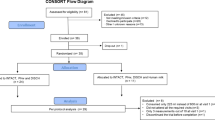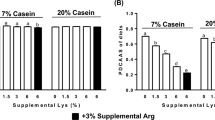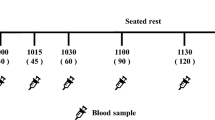Abstract
Background/Objectives:
Growth hormone (GH) is an important regulator of growth and body composition. It has been shown that GH release can be promoted by administration of various amino acids (AAs), such as arginine and lysine, that are present in soy protein. We previously showed that oral ingestion of soy protein stimulates the GH release, it is not known however to which extent other proteins stimulate the GH secretion.
Subjects/Methods:
Ingestion of soy protein (soy), gelatin protein (gelatin), α-lactalbumin protein (α-lactalbumin) and milk protein (milk) were compared on their GH-stimulating capacity. After oral ingestion of protein (0.6 g protein per kg bodyweight), blood was sampled every 20 min for 5 h to analyze GH, AA, insulin and glucose concentrations. The study was performed in eight healthy women (aged 19–26 years; body mass index 19–26 kg/m2) in a randomized, single blind, placebo-controlled crossover design.
Results:
GH responses were more increased after ingestion of gelatine (8.2±1.1 μg/l) compared with ingestion of soy, α-lactalbumin and milk (5.0±0.8, 4.5±0.6 and 6.4±1.0 μg/l, respectively) (P<0.05). After ingestion of each protein, GH responses were higher compared with placebo ingestion (P<0.05). Simultaneously ingestion of gelatin resulted in the highest serum-arginine concentrations (ARG) compared with after ingestion of the other proteins (P<0.05). Insulin as well as glucose concentrations were not different after ingestion of the various proteins (P<0.05).
Conclusions:
The GH-promoting activity of protein depends on the protein source, in that, gelatin protein is the most potent GH stimulator. Arginine may be the responsible AA in the GH-promoting effect of gelatin, although each protein may have its own specific AA-spectrum involved in the stimulation of the somatotropic axis.
This is a preview of subscription content, access via your institution
Access options
Subscribe to this journal
Receive 12 print issues and online access
$259.00 per year
only $21.58 per issue
Buy this article
- Purchase on Springer Link
- Instant access to full article PDF
Prices may be subject to local taxes which are calculated during checkout


Similar content being viewed by others
References
Abumrad NN, Rabin D, Diamond MP, Lacy WW (1981). Use of a heated superficial hand vein as an alternative site for the measurement of amino acid concentrations and for the study of glucose and alanine kinetics in man. Metabolism 30, 936–940.
Boirie Y, Dangin M, Gachon P, Vasson MP, Maubois JL, Beaufrere B (1997). Slow and fast dietary proteins differently modulate postprandial protein accretion. Proc Natl Acad Sci USA 94, 14930–14935.
Cadogan J, Eastell R, Jones N, Barker ME (1997). Milk intake and bone mineral acquisition in adolescent girls: randomised, controlled intervention trial. BMJ 315, 1255–1260.
Castell LM, Poortmans JR, Newsholme EA (1996). Does glutamine have a role in reducing infections in athletes? Eur J Appl Physiol Occup Physiol 73, 488–490.
Chromiak JA, Antonio J (2002). Use of amino acids as growth hormone-releasing agents by athletes. Nutrition 18, 657–661.
Collier SR, Casey DP, Kanaley JA (2005). Growth hormone responses to varying doses of oral arginine. Growth Horm IGF Res 15, 136–139.
Dangin M, Boirie Y, Garcia-Rodenas C, Gachon P, Fauquant J, Callier P et al. (2001). The digestion rate of protein is an independent regulating factor of postprandial protein retention. Am J Physiol Endocrinol Metab 280, E340–E348.
Flynn NE, Bird JG, Guthrie AS (2009). Glucocorticoid regulation of amino acid and polyamine metabolism in the small intestine. Amino Acids 37, 123–127.
Giovannucci E, Pollak M, Liu Y, Platz EA, Majeed N, Rimm EB et al. (2003). Nutritional predictors of insulin-like growth factor I and their relationships to cancer in men. Cancer Epidemiol Biomarkers Prev 12, 84–89.
Gunn IR (1986). Tests for growth hormone deficiency. Lancet 1, 47–48.
Hameed M, Lange KH, Andersen JL, Schjerling P, Kjaer M, Harridge SD et al. (2004). The effect of recombinant human growth hormone and resistance training on IGF-I mRNA expression in the muscles of elderly men. J Physiol 555, 231–240.
Heaney RP, McCarron DA, Dawson-Hughes B, Oparil S, Berga SL, Stern JS et al. (1999). Dietary changes favorably affect bone remodeling in older adults. J Am Diet Assoc 99, 1228–1233.
Holmes MD, Pollak MN, Willett WC, Hankinson SE (2002). Dietary correlates of plasma insulin-like growth factor I and insulin-like growth factor binding protein 3 concentrations. Cancer Epidemiol Biomarkers Prev 11, 852–861.
Hoppe C, Molgaard C, Juul A, Michaelsen KF (2004a). High intakes of skimmed milk, but not meat, increase serum IGF-I and IGFBP-3 in eight-year-old boys. Eur J Clin Nutr 58, 1211–1216.
Hoppe C, Udam TR, Lauritzen L, Molgaard C, Juul A, Michaelsen KF (2004b). Animal protein intake, serum insulin-like growth factor I, and growth in healthy 2.5-y-old Danish children. Am J Clin Nutr 80, 447–452.
Isidori A, Lo Monaco A, Cappa M (1981). A study of growth hormone release in man after oral administration of amino acids. Curr Med Res Opin 7, 475–481.
Johannsson G, Bengtsson BA (1999). Growth hormone and the metabolic syndrome. J Endocrinol Invest 22, 41–46.
Knopf RF, Conn JW, Fajans SS, Floyd JC, Guntsche EM, Rull JA (1965). Plasma growth hormone response to intravenous administration of amino acids. J Clin Endocrinol Metab 25, 1140–1144.
Ma J, Giovannucci E, Pollak M, Chan JM, Gaziano JM, Willett W et al. (2001). Milk intake, circulating levels of insulin-like growth factor-I, and risk of colorectal cancer in men. J Natl Cancer Inst 93, 1330–1336.
Merimee TJ, Rabinowtitz D, Fineberg SE (1969). Arginine-initiated release of human growth hormone. Factors modifying the response in normal man. N Engl J Med 280, 1434–1438.
Ohsumi M, Shi X, Tuchiya T, Tujioka K, Lyou S, Hayase K et al. (2007). The role of growth hormone and amino acids on brain protein synthesis in aged rats given proteins of different quantity and quality. Amino Acids 32, 247–253.
Rich-Edwards JW, Ganmaa D, Pollak MN, Nakamoto EK, Kleinman K, Tserendolgor U et al. (2007). Milk consumption and the prepubertal somatotropic axis. Nutr J 6, 28.
Rogers IS, Gunnell D, Emmett PM, Glynn LR, Dunger DB, Holly JM (2005). Cross-sectional associations of diet and insulin-like growth factor levels in 7- to 8-year-old children. Cancer Epidemiol Biomarkers Prev 14, 204–212.
Saggese G, Ranke MB, Saenger P, Rosenfeld RG, Tanaka T, Chaussain JL et al. (1998). Diagnosis and treatment of growth hormone deficiency in children and adolescents: towards a consensus. Ten years after the Availability of Recombinant Human Growth Hormone Workshop held in Pisa, Italy, 27–28 March 1998. Horm Res 50, 320–340.
Sartorio A, Agosti F, Marazzi N, Trecate L, Silvestri G, Lafortuna C et al. (2004). Gender-, age-, body composition- and training workload-dependent differences of GH response to a discipline-specific training session in elite athletes: a study on the field. J Endocrinol Invest 27, 121–129.
Scacchi M, Pincelli AI, Cavagnini F (1999). Growth hormone in obesity. Int J Obes Relat Metab Disord 23, 260–271.
van Vught AJ, Nieuwenhuizen AG, Brummer RJ, Westerterp-Plantenga MS (2008). Effects of oral ingestion of amino acids and proteins on the somatotropic axis. J Clin Endocrinol Metab 93, 584–590.
Veldhuis JD, Roemmich JN, Richmond EJ, Rogol AD, Lovejoy JC, Sheffield-Moore M et al. (2005). Endocrine control of body composition in infancy, childhood, and puberty. Endocr Rev 26, 114–146.
Walsh NP, Blannin AK, Robson PJ, Gleeson M (1998). Glutamine, exercise and immune function. Links and possible mechanisms. Sports Med 26, 177–191.
Welbourne TC (1995). Increased plasma bicarbonate and growth hormone after an oral glutamine load. Am J Clin Nutr 61, 1058–1061.
Acknowledgements
This research did not receive any specific grant from any funding agency in the public, commercial or not-for-profit sector.
Author information
Authors and Affiliations
Corresponding author
Ethics declarations
Competing interests
The authors declare no conflict of interest.
Rights and permissions
About this article
Cite this article
van Vught, A., Nieuwenhuizen, A., Veldhorst, M. et al. The effects of dietary protein on the somatotropic axis: a comparison of soy, gelatin, α-lactalbumin and milk. Eur J Clin Nutr 64, 441–446 (2010). https://doi.org/10.1038/ejcn.2010.21
Received:
Revised:
Accepted:
Published:
Issue Date:
DOI: https://doi.org/10.1038/ejcn.2010.21



